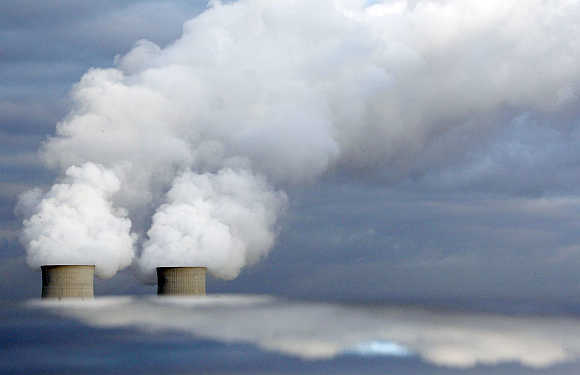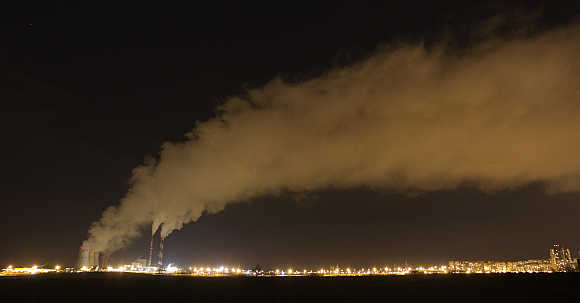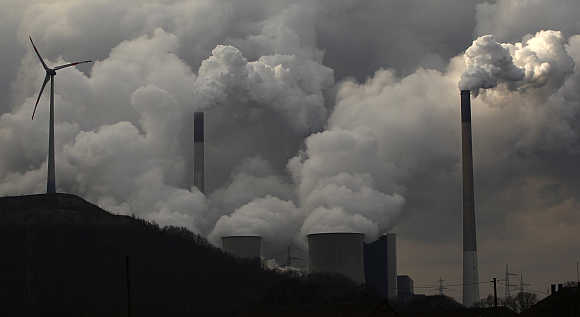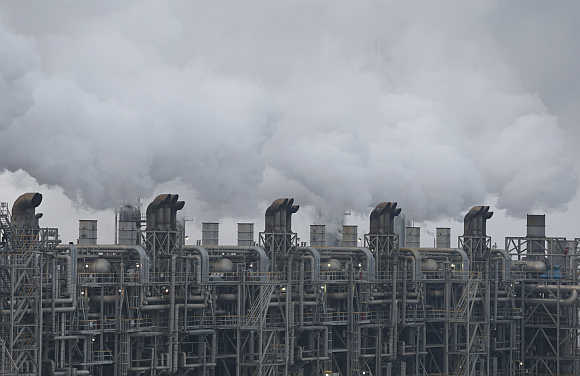Photographs: Regis Duvignau/Reuters Gerard Wynn in London
A new deal to curb carbon emissions could copy features from the Montreal Protocol, which the United States and China favoured over its Kyoto counterpart in an agreement on greenhouse gases at the weekend. The 1987 Montreal agreement bans chemicals that destroy the Earth's protective ozone layer, such as chlorofluorocarbons formerly used as refrigerants and propellants in aerosol sprays, while the 1997 Kyoto Protocol is meant to curb greenhouse gases.
The United States and China, however, agreed on Saturday to use the Montreal Protocol to control the use of hydrofluorocarbons. HFCs are used increasingly as a substitute for ozone-depleting chemicals banned under the Montreal pact. Though they do not deplete the ozone layer, they are powerful greenhouse gases.
"The United States and China will work together and with other countries to use the expertise and institutions of the Montreal Protocol to phase down the consumption and production of HFCs, among other forms of multilateral cooperation," the United States said in a statement on Saturday.
"A global phase-down of HFCs could potentially reduce some 90 gigatons of CO2 (carbon dioxide) equivalent by 2050, equal to roughly two years' worth of current global greenhouse gas emissions."
...
Montreal Protocol shows way for climate action
Image: A gas-fired power station during a frosty night in Minsk, Ukraine.Photographs: Vasily Fedosenko/Reuters
The decision reflects the outstanding success of the Montreal agreement, which details a particular timetable to ban each ozone-depleting substance. A new climate deal, meant to be agreed by 2015 for implementation from 2020, could divide action similarly - by specific gases or economic sectors rather than presenting economy-wide targets to curb total greenhouse gas emissions.
The Montreal Protocol has achieved greater global participation than its Kyoto counterpart, which has failed to gain the support of the United States. Kyoto was ratified by 191 countries and Montreal by 197, according to the United Nations, but real action on Kyoto was limited to only 37 nations because it required only industrialised countries to make cuts in greenhouse gas emissions.
That number dwindled to about 30 under a Kyoto extension agreed in Qatar last December, with the withdrawal of major developed countries including Russia, Canada and Japan. The Montreal agreement, meanwhile, requires action by all countries, while giving developing nations more time to phase out the various ozone-depleting substances.
Comparing action since 1990, the Kyoto Protocol baseline year, global carbon emissions have risen about 53 per cent, BP energy data show, while global production of controlled ozone-depleting chemicals has fallen by more than 96 per cent.
...
Montreal Protocol shows way for climate action
Image: A coal power plant of German utility giant E.ON in Gelsenkirchen, Germany.Photographs: Ina Fassbender/Reuters
The Montreal pact has a number of advantages over Kyoto, promoting greater participation and ambition.
i) A far narrower economic impact thanks to the focus on the chemical industry rather than global energy.
ii) The cost of switching to alternative cooling fluids and substitutes for aerosol sprays was small for producers and consumers.
iii) The cost of inaction was enormous in terms of more skin cancer deaths because of an increase in the size of the hole in the ozone layer during the 1980s, compared with the less certain effects of climate change.
iv) Public concern over the risk of skin cancer generated legislative momentum in the United States, which in turn helped to push global action.
v) By achieving broad participation, the Montreal Protocol eased concerns over the possibility of industrial companies relocating to countries with more lax controls.
vi) Procedures that banned ODS trade with countries not signed up to the protocol. The equivalent under a climate agreement could be a ban on imports of products that fail to meet certain standards, such as less efficient cars.
Experience from the Montreal Protocol suggests that the United States will only sign up to a climate agreement that has lower costs.
...
Montreal Protocol shows way for climate action
Image: A plant of Samsung Total Petrochemicals in Seosan, about 150km south of Seoul, South Korea.Photographs: Lee Jae-Won/Reuters
That is reflected by its enthusiasm for curbs in HFC greenhouse gases. The country's HFC emissions have risen 12 per cent since 2005, more than any other significant greenhouse gas, UN data show. But cutting them could be quite easy. The US Environmental Protection Agency last year listed 12 substitutes available now for aerosols, five for air conditioning units and nine in refrigeration products. (Benefits of Addressing HFCs under the Montreal Protocol, EPA, June 2012)
As for the task of focusing climate action on particular greenhouse gases and economic sectors, a report published by the International Energy Agency on Monday said that action on four policies was achievable at "no net economic cost" (Redrawing the energy-climate map, IEA, June 2013).
"They meet key criteria: they can deliver significant reductions in energy-sector emissions by 2020; they rely only on existing technologies; they have already been adopted and proven in several countries; and, taken together, their widespread adoption would not harm economic growth in any country or region," the report said.
The four policies were: the adoption of energy efficiency measures, including autos; limiting the construction of inefficient coal plants; minimising methane emissions from oil and gas production; and accelerating the phase-out of fossil fuel subsidies. These could be a template for dividing up climate action both before 2020 and under a new deal, making some commitment achievable for all countries.






article